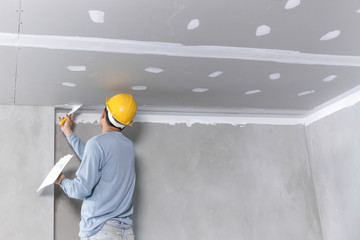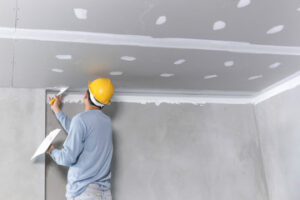
Drywall Repair Basics
Drywall is pretty tough stuff, but it’s not indestructible. Whether from a doorknob, a child’s toy, or moving furniture, your walls can get dented and damaged. Small dents, cracks or holes in your drywall can be repaired relatively quickly and easily with a few key tools. With time and effort, your wall will look new again.
 Drywall Repair Las Vegas can typically fix drywall damage in a fraction of the time it would take an amateur to complete the same task. The time savings alone can offset the cost of hiring a professional.
Drywall Repair Las Vegas can typically fix drywall damage in a fraction of the time it would take an amateur to complete the same task. The time savings alone can offset the cost of hiring a professional.
Drywall repair is a common home improvement project that can range from simply patching up small holes to replacing entire sections of drywall in curved walls or high ceilings. It can cost anywhere from $60-$200 for minor damage and up to $500-3,000+ for more extensive repair projects. Different factors impact the price of drywall repair, including location, underlying causes, and size of damage.
Small drywall repairs are usually within the ability of most homeowners. A drywall patch kit and some premixed drywall compound (also known as spackle) are all that is needed for most small dents or holes in drywall. A few dollars will purchase a five-gallon bucket of either lightweight or all-purpose drywall compound, depending on preference. Lightweight compound is less expensive, dries faster, and takes less effort to sand smooth.
If your drywall is damaged by a large crack, or you need to replace an entire section of drywall in a curved wall or ceiling, then it will be best to hire a drywall contractor. These types of projects require more skill and expertise, and can be very complicated if they are not completed properly.
Corner drywall cracks can be caused by many things, from improper installation to shifting walls and settling. They can also be the result of a leaking roof, which can infiltrate ceiling drywall and cause moisture damage.
When two sheets of drywall meet at a wall or ceiling corner, they are joined by an L-shaped metal strip called a corner bead. The bead is then concealed by a joint compound layer. Over time, corner bead can become dented or damaged by items being hung on the wall, vacuuming, or kids flinging their toys.
When repairing drywall damaged by mold, the process may include additional costs for testing and sanitization of surrounding areas, and potentially a full mold remediation. This can add up to a significant amount, which can be a major deterrent for those who wish to perform their own repairs.
Drywall Repair Time
Drying time is one of the biggest factors in drywall repair. While it may be possible for a homeowner to fix small holes with some materials and patience, large repairs or those that involve water damage require the attention of professionals. They have the equipment and experience to ensure a quick and effective repair.
Cracks in drywall often occur due to the natural settling of the house or changes in temperature. If the crack isn’t repaired quickly, it can lead to further damage and even structural issues in the house. Homeowners should sand the crack smooth and then apply a thin coat of joint compound. Once the compound dries, it can be sanded again and a second coat applied if needed.
Another common drywall problem is popped nails and screws. These can happen as the lumber shrinks, and homeowners should yank the nail or screw with pliers to remove it. Once the hole is cleaned out and sanded, it’s easy to fill in with a bit of joint compound and drive the nail or screw back into place.
Nail and screw pops aren’t permanent, but they can be unsightly. One way to fix them is to cut off the head of the nail or screw and then hammer in a new nail or screw, making sure to hit it well below the surface. Once the hole is cleaned out and resanded, it’s ready for paint.
Drywall dents aren’t only unsightly but can also cause damage to other parts of the house if left untreated. These dents can be caused by a variety of activities, including vacuuming, kids flinging toys, or moving furniture. Most drywall is protected by an L-shaped metal strip called corner bead, which can easily get dented by furniture or the action of a door knob.
Mold in drywall isn’t only unsightly; it can be dangerous to the health of residents, especially those with preexisting respiratory problems. Mold spores can become airborne, and if it isn’t treated promptly, it can spread throughout the entire house.
It’s usually best to hire professional contractors for any repairs that require more than a few hours of work, such as whole-sheet drywall replacement or large holes and dents. They have the proper equipment for a faster repair and are experts at matching paint, priming and repainting.
Drywall Repair Materials
When it comes to repairing holes in drywall, the right products can make all the difference. There are a number of drywall repair kits available to suit the kind of damage you’re fixing, including everything from basic filler kits to more thorough mending agents. These products can cover cracks, dings, and holes to make the wall nearly invisible, but it’s important to use them with finesse. You’ll need to feather the compound into the rest of the wall and sand it carefully to ensure a smooth finish.
For small repairs, look for a drywall patch and joint compound in powder form that sets up by chemical reaction. It works well for repairing screw holes and other wall dings, but it may not be sufficient for larger drywall damage. A drywall mud with a faster setting time may be better in those cases.
A good general-purpose drywall repair product is a ready-mixed all-purpose plaster, which is available in white to off-white shades and offers easy sanding. This type of mending plaster works on walls, ceilings and even wood surfaces, and is great for covering rough areas and preparing them for painting.
Another common drywall repair product is an adhesive sheetrock patch, which has the same qualities as a plaster and can be used in the same way. This mending product is available in pre-mixed versions as well as a dry mix that you can apply using a plastic compound spreader or a metal putty knife.
This is a quick and easy way to fix holes in drywall. It’s a great option for people who don’t want to bother with a lot of tools or fussing with sanding and masking. The company behind the Eclipse product claims that it can be used to make a wall look new again in minutes, and many contractors agree. Some of the most popular brands come in packages with multiple patches and a plastic tool for spreading the compound. They’re often available at home improvement centers and hardware stores. You can also find them online. It’s a good idea to buy more than one pack, so you always have supplies on hand for when you need them.
Drywall Repair Tips
Drywall is pretty tough stuff, but it’s not indestructible. Even if you’re careful, you may have to deal with dents in the corners of rooms caused by the vacuum cleaner or your child flinging a toy. The good news is that repairing drywall isn’t difficult, but you do need to know the right steps.
Small dents and scratches can be repaired with a thin layer of joint compound (also known as drywall mud). Apply the compound using a putty knife that’s specifically designed for drywall, rather than a regular utility knife, then smooth it until it’s flush with the wall or ceiling.
Large holes require a bit more work. First, use your stud finder to locate the studs around the hole and mark them with a pencil. Then cut a piece of drywall backing or plywood to fit the size and shape of the hole, making sure it extends at least 3/4 inch on either side of the hole.
Once you have a replacement piece, screw it to the studs and joists with drywall screws. Then cover the patch and surrounding area with mesh joint tape to strengthen the repair, reduce shifting, and help prevent future cracks. Then spread another thin coat of joint compound over the tape and use a putty knife to smooth it and feather it into the surrounding area.
Nail and screw pops aren’t just unsightly—they’re also dangerous. If you hear a “pop” and feel resistance when screwing in a new fastener, twist the nail or screwdriver to ensure that it’s actually hitting solid wood. If it isn’t, yank out the old fastener and drive in a new one.
Drywall cracks often appear above and below doors or windows, but they can happen anywhere in the house. They’re usually caused by lumber shrinkage and settling, and can be difficult to spot. If you have a vertical crack, use a sanding sponge to sand it down and then apply a second thin coat of joint compound. Once it dries, sand it again and touch up any areas where the primer or paint has peeled.
